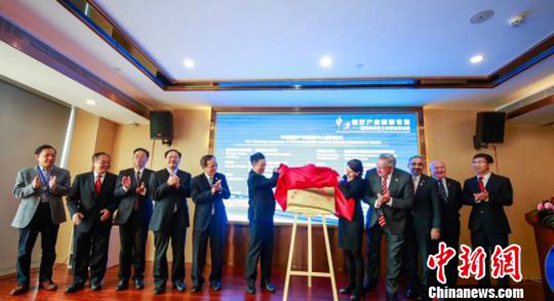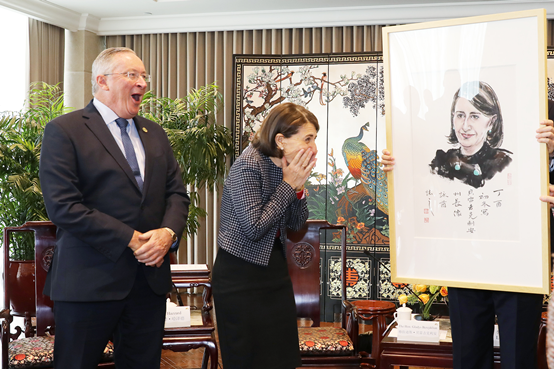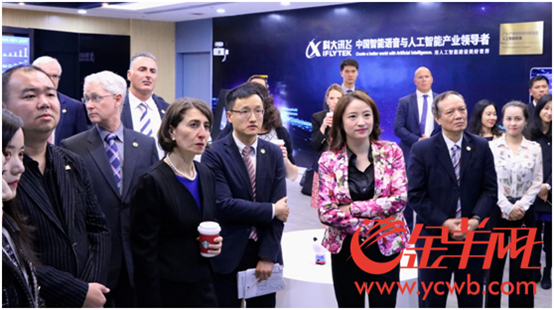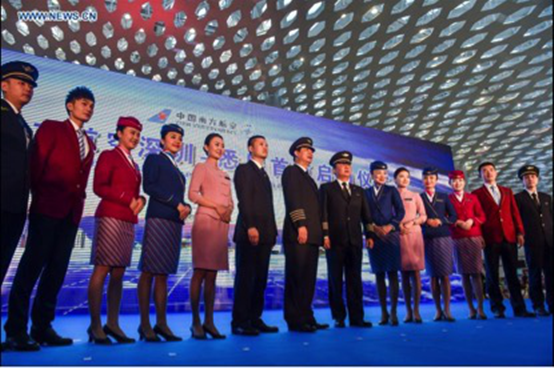Before the interview, Gladys Berejiklian, Premier of New South Wales, asked about our Chinese names and their special meanings, and said she keeps learning Mandarin both because of its convenience and the huge Chinese community living near where she works in New South Wales. “I can count in Cantonese as well. I had a friend from Guangzhou when I was a little girl,” she said.
Premier was surprised by the gift given by Guangdong —her portrait by a local painter. [Photo provided to Newsgd.com]
Guangdong and New South Wales, the biggest economy in Australia, have a long history of close relationship. The two places established a sister relationship in 1979, making them the first pair of international sister provinces in China.
To celebrate the 38th anniversary of the sister relationship, Gladys Berejiklian led her delegation in a visit to Guangdong and participate in the joint economic meeting earlier this month.
“The joint meeting is significant for both Guangdong and NSW. Over the past 38 years, it has allowed leaders of two places to consider challenges and opportunities in our regions together,” stated Ma Berejiklian.
Gladys Berejiklian and her delegation visit IFLYTEK in Guangzhou. IFLYTEK is a renowned company dedicated to intelligent speech and language technologies. [Photoycwb.com]
This year, Gladys Berejiklian said she was impressed by Guangdong's plan to develop the Greater Bay area with Hong Kong, Macao and all the trade zones and economic zones in the Pearl River Delta. “I think this will be a very exciting proposition in the future. And I’m very keen to make sure New South Wales will be part of this successful story,” she said.
More specifically, Li Xi, Party Chief of Guangdong, Ma Xingrui, Governor of Guangdong and Gladys Berejiklian outlined four major areas for further cooperation.
“Leaders of Guangdong are very committed to alleviating poverty and trying to raise the standard of living of all citizens,” said Berejiklian, “aiming for this goal, we will work closely in (the fields of) health, education, high-tech and smart cities.”
Newsgd.com: as you have been here for a few days and visited both Guangzhou and Shenzhen during this trip, how did these cities impress you? Could you highlight some opportunities for cooperation in the technology and smart city sectors?
Gladys Berejiklian: Guangzhou and Shenzhen are both amazing growth stories. In Shenzhen, for example, we saw how they developed a smart city in a very short period of time.
Shenzhen is leading the world now in technology, especially IT and AI while it’s a great incubator for new jobs and new industries. On the other hand, I saw a large number of electronic buses and cars on streets, making the city very livable and developed in balance.
Crew members of the new regular flight from Shenzhen to Australia's Sydney attend the launch ceremony for the flight in Shenzhen, south China's Guangdong Province, Jan. 27, 2016. (Xinhua/Mao Siqian)
And Shenzhen Airport is growing really fast. I was happy to hear there will be direct flights between Shenzhen and Sydney soon in the future. So I definitely got some ideas during the trip. I can take these ideas back to New South Wales because both Guangzhou and Shenzhen are great examples of how to develop smart cities.
In terms of cooperation, we want to encourage companies and organizations to participate in building our second airport in Western Sydney and the city around it. The program will run from 2018 to 2026. This will be a great opportunity for our Guangdong partners because I’ve seen their excellent experience in building Guangzhou and Shenzhen as smart cities from the ground up.
Newsgd.com: since the sister relationship has been in place for nearly 40 years, what do you think is the most impressive change in Guangdong? And how has cooperation between our two regions been changing?
Gladys Berejiklian: the most impressive change is the attitude. The openness and the very Chinese characteristics of Guangdong have created cities as Guangzhou and Shenzhen. And I’m very excited about the development of the Greater Bay Area as well as the trade zones here.
I think the relationship between Guangdong and New South Wales is tighter than ever with a strong basis of trust and friendship. We've been doing business with each other and having cultural exchanges for many years.

A Sino-Australian health innovation center launched in Guangzhou’s Nansha District, which is located at the center of Greater Bay Area. The center will offer free service for Australian health programs in Guangdong. And it will set up a branch in Australia to introduce potential programs. [PhotoChinanews.com]
Now that Guangdong is entering a new era of modernization, I see more possibilities to cooperate, and eventually to improve the living standards of our citizens. Today during the joint economic meeting we signed cooperation agreements focusing on health, education, technology and smart cities. All of these areas are closely related to people’s lives.
For example, I brought the health minister of New South Wales here. And he has been having meetings with many local hospitals and local medical experts. And during this trip, I witnessed the launch of a health innovation center to provide actual services to further cooperation between Guangdong and New South Wales.
During the meeting with senior officers and business leaders in Guangdong, I felt deeply that we are important to each other and both treasure our sister relationship very much. It makes me feel even more committed to strengthening ties between the two sides.
Reported by Jasmine Yin
Edited by Simon Haywood, Olivia Ouyang



















